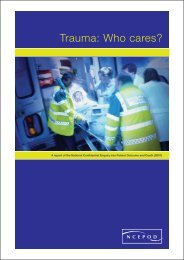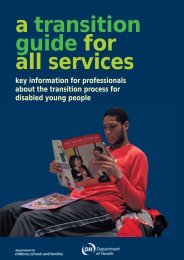(CAMHS) and Schools - London Health Programmes
(CAMHS) and Schools - London Health Programmes
(CAMHS) and Schools - London Health Programmes
You also want an ePaper? Increase the reach of your titles
YUMPU automatically turns print PDFs into web optimized ePapers that Google loves.
3.9 Resources spent on working with schools<br />
In the questionnaire, respondents were asked to estimate the proportion of their<br />
resources spent on working in schools. Many commented that this was difficult but<br />
107 (70%) did make estimates. Just over half of these <strong>CAMHS</strong> spent less than 10% of<br />
their resources on work in schools, <strong>and</strong> the average is 15%. This is higher than found<br />
in studies elsewhere (Audit Commission, 1999).<br />
Table 6: Resources spent on work in schools<br />
Percentage of resources spent on work in<br />
schools<br />
Number of<br />
<strong>CAMHS</strong><br />
0-5 29<br />
6-10 26<br />
11-15 14<br />
16-20 14<br />
21-25 5<br />
26 + 19<br />
Total 107<br />
Average 15<br />
No response/ unable to estimate 45<br />
Many of the respondents highlighted resource issues as a problem, especially those<br />
that are a small service. The main reason cited for not working in schools was not<br />
having the time or funding to do so. One respondent commented that working on<br />
projects in schools had detracted from their core work <strong>and</strong> had led to an increase in<br />
waiting list, <strong>and</strong> low morale within the service.<br />
79% of the <strong>CAMHS</strong> who reported working in schools are using core funding 28% are<br />
using project funding (12% are using a combination of both). Many were linked to<br />
other initiatives including Sure Start (52), <strong>Health</strong> Action Zones or <strong>Health</strong><br />
Improvement Strategies (30) Education Action Zones (24) <strong>and</strong> <strong>Health</strong>y <strong>Schools</strong> (22),<br />
Connexions (18) <strong>and</strong> Excellence in Cities (5). Other initiatives mentioned were<br />
<strong>CAMHS</strong> modernisation (5), On Track (3), Quality Protects (2), SRB <strong>and</strong> social<br />
inclusion.<br />
3.10 Summary of key findings from chapter 3<br />
<strong>CAMHS</strong> structures are very different across Engl<strong>and</strong>, <strong>and</strong> it is hard to get an overall<br />
picture of the scale <strong>and</strong> pattern of the work they are doing with schools. For example,<br />
they cover different sizes of geographical area, may be based in clinical or community<br />
settings.<br />
The majority of <strong>CAMHS</strong> services which responded to the survey did some work with<br />
schools (89%). Within this, was a wide variety of practice <strong>and</strong> structures. The most<br />
common form of work was consultation <strong>and</strong> support to school staff, often on a case<br />
by case basis with children who had been referred to their service. Other support to<br />
school staff was consulting on behaviour, training <strong>and</strong> supervision to a range of<br />
school based staff, <strong>and</strong> contributing to health promotion activities.

















